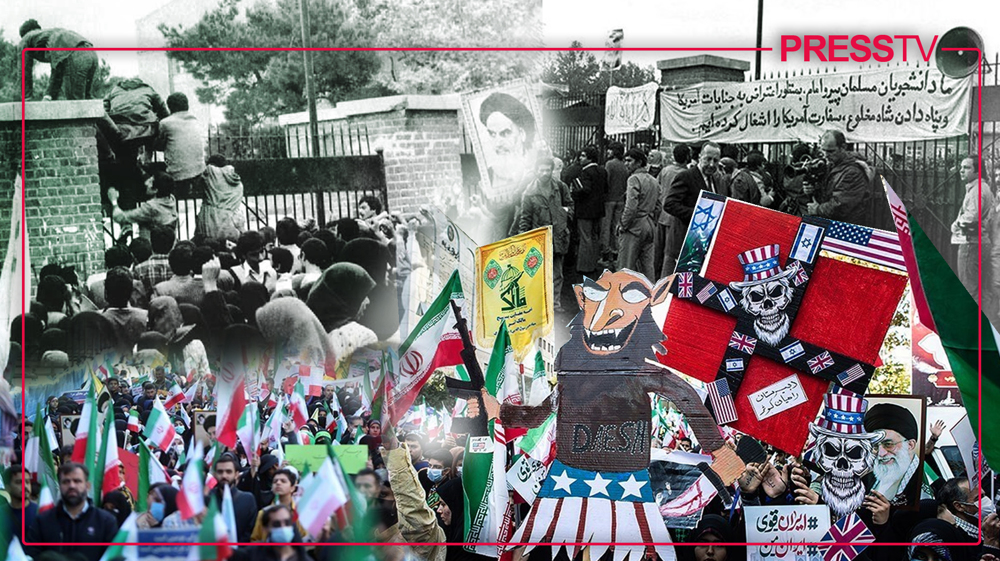Explainer: Why is Aban 13 marked in Iran as day of fighting global arrogance?
By Meisam Kazemi
Like every year, tens of thousands of people poured into the streets of Tehran and other Iranian cities on Saturday to reaffirm their pledge of allegiance to the principles of the 1979 Islamic Revolution.
November 4, or Aban 13 in the Iranian calendar year, marks three important events in contemporary Iranian history: the exile of the late founder of the Islamic Republic Imam Khomeini, the student protest of 1978, and the takeover of the former US embassy in Tehran in 1979.
Leader of the Islamic Revolution Ayatollah Seyyed Ali Khamenei, speaking to a gathering of students on Wednesday, referred to these three events while explaining the reasons behind the US enmity toward the Islamic Republic of Iran.
Imam Khomeini's exile
In early 1963, Imam Khomeini issued a strongly-worded declaration condemning the then West-backed Iranian dictator's plans to introduce the “White Revolution” in the country, a US-inspired package of measures designed to give his regime a false progressive facade.
The architect of the Islamic Revolution also issued a manifesto in which he listed various ways in which the Pahlavi ruler was seen spreading moral corruption in the country.
At the beginning of June of that year, he delivered powerful speeches in which he compared the Shah to Yazid ibn Muawiyah, which resulted in the Khordad 15 mass protests across Iran.
These protests were brutally suppressed, with hundreds of protesters killed. Imam Khomeini was kept under house arrest for 8 months and was eventually released in 1964.
At the beginning of November 1964, the charismatic leader of the Islamic Revolution made a denunciation of both the Shah and the US, this time in response to the diplomatic immunity granted to US military staff in Iran by the Shah, which he described as a capitulation.
As a result, he was arrested again and sent into exile on November 4, first to Turkey, from where he went to Najaf in Iraq in 1965, and finally to Neauphle le Château in France in 1978.
Imam Khomeini spent over 14 years in exile, a significant period during which he defined the political concept of "Guardianship of the Islamic Jurist" (Velayat-e faqih) that laid the foundation for the Islamic Republic in 1979 after a long struggle.
From exile, he led popular mass protests across Iran that ultimately resulted in the overthrow of the Pahlavi dictatorship and his triumphant return in February 1979.
Student protests
Another important event came on November 4, 1978, when thousands of Iranian students gathered inside the campus of the University of Tehran to protest against the Pahlavi dictatorship.
The regime forces responded brutally and indiscriminately with tear gas, batons, and bullets, killing at least 56 young students and injuring hundreds of others.
“The attitude of the Americans toward this important day and its congenial and unifying gatherings is that of anger and frustration because this day is both the embodiment of the United States’ evils and the embodiment and proof of America’s vulnerability and the possibility of its defeat,” Ayatollah Khamenei said in his speech on November 4 last year
US embassy takeover
The most important and historic event associated with November 4 is the seizure of the American embassy in Tehran, also known as the ‘Den of Espionage,’ which is why the day is also known as the ‘National Day of the Fight against Global Arrogance.’
In November 1979, around 400 university students, who later came to be known as the ‘Muslim Student Followers of the Imam's Line,’ climbed over the walls of the US embassy in central Tehran and seized the building, diplomatic staff and their sensitive intelligence documents.
Ayatollah Khamenei, in his speech on Wednesday, said the takeover of the den of espionage in Tehran “dealt a blow to the US and ruined its reputation in the world.”
He said the documents obtained from the American embassy made it clear that it had become a center of conspiracy and espionage against Iran.
The takeover of the embassy came after Americans allowed the deposed Iranian dictator, who had run away with millions of dollars of money from the state exchequer, to enter the United States
The protesters, supported by most of the political groups in Iran, demanded the return of Mohammad Reza Pahlavi to stand trial for his many crimes.
They also demanded an apology from the US government for its interference in the internal affairs of Iran, including the illegal overthrow of Prime Minister Mohammad Mosaddegh in 1953.
In 1953, the British and American spy agencies helped Iranian royalists depose Mosaddegh in a military coup, making the Iranian nation a hostage of US-backed Pahlavi's dictatorship for 26 years.
American leaders were initially opposed to negotiations with Tehran to have their diplomats and spies released, showing their arrogance.
They resorted to economic and military threats against Iran, including Jimmy Carter's approval of Operation Eagle Claw, which failed miserably and damaged US prestige worldwide.
The American embassy staffers were finally released on January 20, 1981, after lengthy negotiations.
It came after the Iraqi Baathist regime of Saddam Hussein, backed by the US and other Western had launched an aggression against Iran that lasted eight years.
Cambridge's most affluent college to divest from arms companies: Report
Leader pays visit to 35th Tehran International Book Fair
Gitmo and Negev: US, Israeli human rights two sides of the same coin
Putin replaces defense minister Shoigu in major shakeup
Iran’s star striker Mehdi Taremi bids farewell to FC Porto with last-minute goal
Iran's authority result of resistance, advances in endless wars: IRGC chief
Gaza’s healthcare system ‘few hours away’ from collapse: Ministry
VIDEO | 28th Tehran international oil, gas expo wraps up










 This makes it easy to access the Press TV website
This makes it easy to access the Press TV website